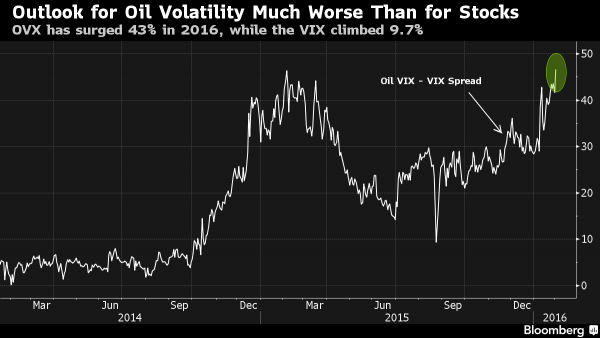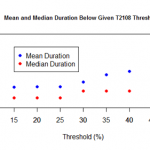While the biggest news of the night had nothing to do with either oil or China, all that mattered to US equity futures trading also was oil and China, and since WTI managed to rebound modestly from their biggest 2-day drop in years, continuing the trend of unprecedented, HFT-driven volatility which has far surpassed that of equities and is shown in the chart below…

… despite the API reporting a jump in oil inventories, rising back over $30, and with China falling only 0.4% overnight after the National Team made a rare, for 2016, appearance and pushed stocks to close at the day’s high, US E-minis were able to rebound from overnight lows in the mid-1880s, and levitate above 1900. Whether they sustain this level remains to be seen.
However, as noted above, the biggest news was neither oil nor China whose rigged volatility is now watercooler humor talk across trading floors, but the BOJ’s Kuroda, who as reported previously, made many headlines overnight during a speech on NIRP such as the following:
What was disturbing about these is that not only was the BOJ unable to push the USDJPY, or Nikkei (which plunged 3.2%) higher, but the Japanese currency surged overnight wiping out almost all post-NIRP losses, and suggesting that central bank credibility is virtually gone. A few more “emergency actions” like the BOJ’s and not all the HFT algos igniting upward momentum will be able to offset the avalanche of selling that is “pent up” and just waiting for the central bank admission of terminal failure, before all markets around the global are concurrently halted “due to market reasons.”
But while US equity futures are enjoying today’s crude levitation, Europe’s benchmark equity gauge dropped for a third day, with Italian banks leading losses, and the Markit iTraxx Europe Index of credit-default swaps on investment-grade companies surpassed 100 basis points for the first time since October 2013. The yen strengthened for a third day. Oil recovered after its biggest two-day drop in almost seven years, buoying Russia’s ruble, and zinc climbed to the highest in almost three months.
Where we stand now:
Looking at regional markets, we start in Asia where the oil slump continued to linger and weigh down on global markets with local markets tracking Wall Street losses as WTI returned to sub-USD 30/bbl levels. Nikkei 225 (-3.2%) underperformed in the region as the dampened sentiment brought forth from oil with pressure also coming from a firmer JPY. ASX 200 (-2.3%) was unable to escape the grasp of the plunge in the energy complex, with the decline in oil dragging the index into negative territory. Shanghai Comp (-0.4%) abided by the trend set between the regional bourses as the index shrugged off the better than prior Caixin PMI readings in which the services figure printed a 6-month high. JGBs were supported by the risk off sentiment in the region alongside spill over buying in USTs, with yields falling to record lows across the curve.
Asian Top News:
European equities opened relatively flat this morning, brushing off the firm risk off sentiment in Asia, which came in spite of positive Chinese services PMI data. As we head into the North American crossover equities are broadly in negative territory however, with a bid in oil preventing a more pronounced selloff. The SMI (-0.0%) outperforms its major counterparts, after Syngenta (+5.7%) confirmed yesterday’s reports that they will be acquired by ChemChina , with the touted figure exceeding USD 43b1n or CHF 475/shr, the largest ever foreign acquisition by a Chinese conglomerate. Elsewhere, luxury names perform well in Europe following LVMH’s (+5.9%) beat on headline revenue, which they posted after the European cash close yesterday.













Leave A Comment